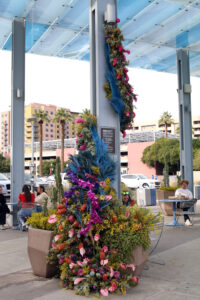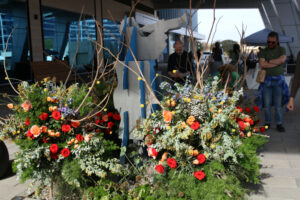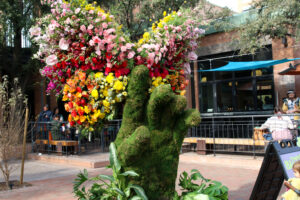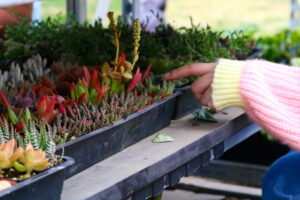- Slug: Tempe Flowers Sustainability. 800 words.
- Photos available.
By Brandelyn Clark
Cronkite News
TEMPE – The second annual Tempe Blooms event lit up downtown Tempe last month, with energy and creativity taking root in the neighborhood.
Attendees strolled through a scene of artists’ live painting, DJs mixing music and vendors showcasing their goods – all while surrounded by the true heart of the festival: vibrant flower arrangements crafted by local florists.
This year, designers behind the event’s arrangements embraced eco-friendly practices and incorporated reusable materials to reduce waste. This shift reflects a budding movement away from traditional floristry to more sustainable alternatives.
Urban Desert Flora
Christina Blodgett, owner of Urban Desert Flora, based her design around the concept of “reduce, reuse, reborn.”
Blodgett’s piece seamlessly intertwined with the outdoor metal art installation of the Amazon corporate building. She framed the sculpture with intricate stick structures, allowing vibrant blooms to weave through the space. Shades of orange and red roses laced a bright contrast against the lush greenery.
“Sustainability is a choice,” Blodgett said.
She explained how the stick structures acted as backbone and allowed for floral movement. rReusable water tubes kept the flowers viable throughout the festival instead of using flower foam, a water-absorbent material common in conventional floristry to promote longevity.
Traditional flower foam is an environmental concern because it is nonbiodegradable, nonrecyclable and full of microplastics. It also contains toxic chemicals, including phenol and formaldehyde, that pose risks to human health and ecosystems. Once discarded, the foam breaks into tiny particles that leak these chemicals into soil and waterways, which contributes to long-term pollution.
Blodgett prioritizes building a relationship with nearby farmers to create floral designs that are sustainable and locally sourced to promote “environmental stewardship and community support.”
Her commitment to sustainability extends beyond the lifetime of the flower. After cleanup, she takes the materials to local compost centers. The waste is mulched and sold back to those same farmers, creating what she calls “a circular model” of recycling.
“Let me compost it. We’re remaking dirt that our farmers and our community go and get stuff for. They go buy that compost and they put it in their yards,” Blodgett said. “Bottom line is, we’re trying not to think in a linear trash model. We’re thinking in a circular model: Rethink, reuse, reborn.”
Watson’s Flowers
Hannah Miles, a designer at Watson’s Flowers, has been with the company since high school. Alongside fellow designers Mekenzie Coburn and Madeline Danielson, Miles helped craft the Tempe Blooms arrangement. Inspired by Arizona’s motto, “Ditat Deus,” meaning “God enriches,” the design captured nature’s beauty and the belief in the divine.
“We just fell in love with that little phrase, and we knew we wanted to do something relating to the beauty of God’s creation and his hand in this beautiful world. And so we came up with the idea of a hand,” Miles said.
The team brought their vision to life using recycled materials. During the Christmas season, the designers collected used wrapping paper from their families to build the structure of the hand. It was then layered with paper-mache made from Trader Joe’s flyers.
While the arrangement incorporated flower foam, Miles explained it was necessary for this particular design.
“There are just some looks that you can’t achieve without it,” Miles said, noting sometimes they must prioritize efficiency.
The business recycles all cardboard and plastic materials and encourages customers to donate vases to the business to reduce waste. Watson’s also donates flowers weekly to local assisted living facilities and schools.
As a fourth-generation family-owned business, Watson’s Flowers has been a staple in the community since 1927. The company embraces traditional floral practices and modern sustainability efforts, reflected in its design choices.
Though Watson’s Flowers is mindful of sustainability, its primary focus remains on creating floral arrangements that honor tradition. These efforts reflect the evolving landscape of the floral industry as businesses shift from traditional designs relying on single-use materials to more sustainable approaches.
KC’s Floral Designs
Daniel Butler and Keili “KC” Summey, the couple behind KC’s Floral Designs, are uprooting traditional floristry with a blend of art and green practices.
This year, Summey’s Polynesian/Pacific Islander heritage inspired their arrangement at Tempe Blooms, where they showcased a vibrant mix of tropical florals and feathers.
Their floral design was not only eye-catching but eco-conscious, crafted without floral foam. Instead, the pair used chicken wire for structure and reusable water vessels to keep the blooms fresh.
After events, Butler and Summey donate leftover arrangements to nursing homes and hospitals to give the flowers a second life and brighten someone’s day in the process.
“The floral industry is so wasteful. … We try to reuse as much as we can,” Butler said. “We only have one world. We only have one planet. Might as well take care of what we have instead of contributing to the pollution of everything else.”
For more stories from Cronkite News, visit cronkitenews.azpbs.org.



